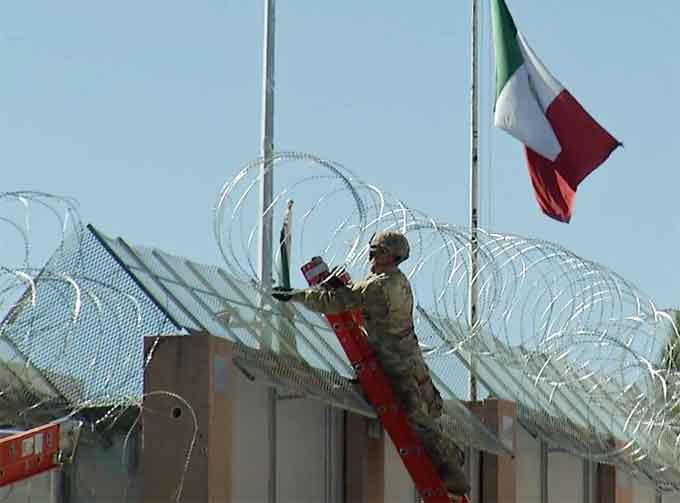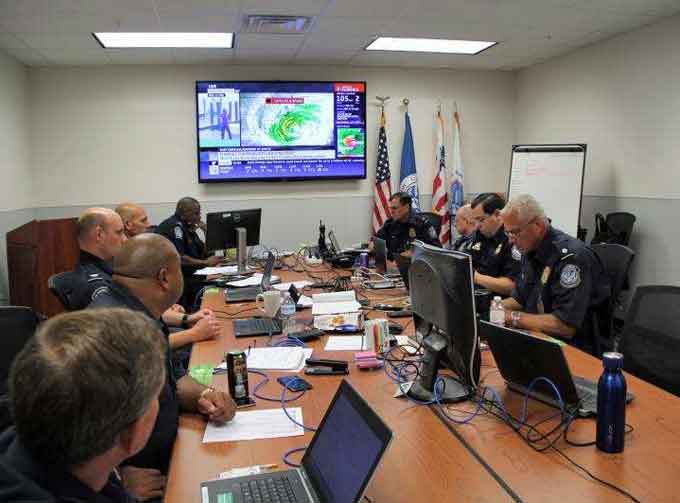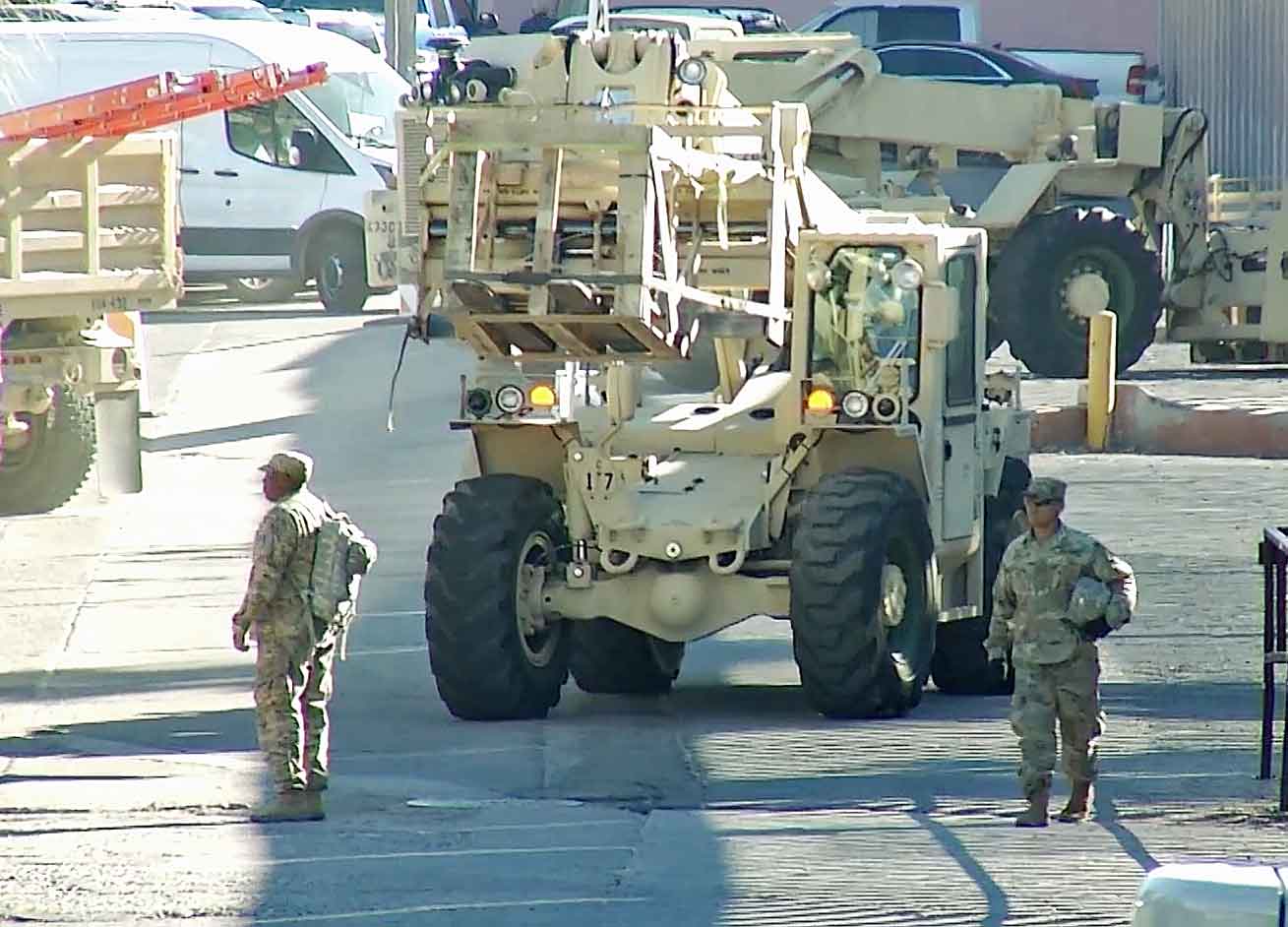Thousands of American military troops joining hundreds of U.S. Customs and Border Protection officers and Border Patrol agents as they hardened the ports of entry, and the images tell part of the story.
While the miles of concertina wire and the tons of traffic barriers intended to funnel the possible crush of thousands of Central American migrants through the official crossing point, plus added personnel going to the southern border, most of which are visible, an aspect not as well-noted in the press has been key to the success of Operation Secure Line’s, namely logistics.
(President Trump escalates push to crack down on illegal immigration policy as hundreds of migrants attempt to rush the U.S. border with Mexico; as Doug McKelway reports from the White House. Courtesy of Fox News and YouTube. Posted on Nov 26, 2018.)
While the Department of Defense provides people, products and expertise, it needs direction from CBP.
“In order to get direction from CBP, we connect them with people on the ground,” said Benjamin Attella, the logistics section chief in CBP’s Area Command in Washington, D.C.
“We give the idea and framework, and they provide the expertise.”
For example, the military has engineers and planners who know how to put in the concertina wire which in turn, link up with the Office of Field Operations Special Response Team and field office members to identify where best to put in the fortification of the port of entry.
(Learn More. Active-duty troops began arriving at the U.S. Mexico border in Arizona last week to support the needs of Customs and Border Protection as part of the Department of Defense’s Operation Secure Line. More than 1,000 troops in total were expected to deploy to Arizona. Their duties so far include installing concertina wire on portions of the fence in Nogales. Military officials have said their mission isn’t to stop the approaching caravan of migrants from Central America, but to support CBP. Courtesy of Arizona 360 and YouTube. Posted on Nov 16, 2018.)
“Up here at headquarters, we’re coordinating all that talking on the ground and making sure those plans are going up the right way through lead field commanders in time so they can start working,” Attella said.
Area Command is a large conference room where every aspect of CBP operations, from Border Patrol, Air and Marine Operations and Field Operations, to finance and personnel specialists, is stationed every day during crisis events to coordinate and consult with each other, as well as DoD partners.

This nerve center of Operation Secure Line was known as an emergency operations center when used to coordinate responses to major natural disasters, such as last year’s hurricanes in Texas, Florida and the Caribbean, however, this latest goes well beyond the walls of the room in CBP’s headquarters building.
“We’re providing logistics material support to the DoD force that is supporting CBP,” said Ralph Laurie, who works in Colorado Springs, Colorado, as the Defense Logistics Agency liaison to the United States Northern Command, the U.S’s defense arm responsible for homeland defense and Defense Support of Civil Authorities operations.
That support includes providing food and water for those troops President Trump sent to help Customs and Border Protection, as well as barrier materials the military has shipped to Texas, Southern California and Arizona.

Those materials include approximately 36 miles of concertina wire (with more on the way), concrete and water-fillable traffic barriers (also known as jersey barriers), and old metal shipping containers the military can no longer use but make for great border barriers.
Those shipping containers don’t cost taxpayers anything extra since they were already bought, used and are now recycled at the border, however total costs amount to up to approximately $4.3 million in materials the Defense Logistics Agency (DLA) is providing so far to support Operation Secure Line.
“Almost all of the material we’re providing is material that we use in some way, shape or form already,” Laurie said.
One thing that helped the military move so much material to the border quickly was DoD anticipating the demand, despite not having many details on what was needed and where.
(Border Patrol Chief Rodolfo Karisch explains how the recent influx of asylum seekers has challenged resources within the agency, as well as how the agency processes people once they’ve been apprehended. Courtesy of Arizona 360 and YouTube. Posted on Nov 16, 2018.)
“We’ve done similar things with the Federal Emergency Management Agency in the past.”
“That’s just how the military operates,” Attella said, referencing how prepositioning really made a big difference.
“You move your troops forward to cut back on that lag time. We train this concept and execute on a smaller scale, but to see the Army do it as doctrine with such efficiency is amazing.”
Just like the experience moving materials across the country, the military is also used to building effective entry control points at its bases in the U.S. and overseas, similar to what CBP has to do with its ports of entry.
“We’ve had a lot of military officers up here (in the Area Command) who have a lot of experience in Afghanistan and Iraq with fortifying operating bases in hot zones,” Attella said.
“This is what they do. They’re experts, and it shows.”
While the Department of Defense has supported CBP at the border in the past, this latest effort between the military and CBP is unprecedented.
(See more of Operation Secure Line in Nogales. Courtesy of KVOA News 4 Tucson and YouTube. Posted on Nov 9, 2018.)
“This is an historical event,” said Louis Godino, CBP’s Area Command deputy commander.
“CBP has never seen a mass of migrants this large come this way at once. DoD has never supported at the border like this. The military has been amazing support in getting us focused on hardening the border.”
Godino said CBP is learning from its military partners and vice versa.
“I think this is just the beginning of a great partnership and an amazing learning experience for both,” he said.
Godino believes having the support of the military will help immensely as the bulk of the migrant caravans arrive at the border.
“It could make a very large difference: a show of force, a show of solidarity and unity for this country,” he said.



















